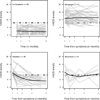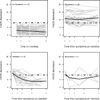Cooccurrence of and remission from general anxiety, depression, and posttraumatic stress disorder symptoms after acute lung injury: a 2-year longitudinal study
- PMID: 25513784
- PMCID: PMC4336582
- DOI: 10.1097/CCM.0000000000000752
Cooccurrence of and remission from general anxiety, depression, and posttraumatic stress disorder symptoms after acute lung injury: a 2-year longitudinal study
Abstract
Objective: To evaluate the cooccurrence, and predictors of remission, of general anxiety, depression, and posttraumatic stress disorder symptoms during 2-year follow-up in survivors of acute lung injury treated in an ICU.
Design: Prospective cohort study, with follow-up at 3, 6, 12, and 24 months post-acute lung injury.
Setting: Thirteen medical and surgical ICUs in four hospitals.
Patients: Survivors among 520 patients with acute lung injury.
Measurements and main results: The outcomes of interest were measured using the Hospital Anxiety and Depression Scale anxiety and depression subscales (scores ≥ 8 indicating substantial symptoms) and the Impact of Event Scale-Revised (scores ≥ 1.6 indicating substantial posttraumatic stress disorder symptoms). Of the 520 enrolled patients, 274 died before 3-month follow-up; 186 of 196 consenting survivors (95%) completed at least one Hospital Anxiety and Depression Scale and Impact of Event Scale-Revised assessment during 2-year follow-up, and most completed multiple assessments. Across follow-up time points, the prevalence of suprathreshold general anxiety, depression, and posttraumatic stress disorder symptoms ranged from 38% to 44%, 26% to 33%, and 22% to 24%, respectively; more than half of the patients had suprathreshold symptoms in at least one domain during 2-year follow-up. The majority of survivors (59%) with any suprathreshold symptoms were above threshold for two or more types of symptoms (i.e., general anxiety, depression, and/or posttraumatic stress disorder). In fact, the most common pattern involved simultaneous general anxiety, depression, and posttraumatic stress disorder symptoms. Most patients with general anxiety, depression, or posttraumatic stress disorder symptoms during 2-year follow-up had suprathreshold symptoms at 24-month (last) follow-up. Higher Short-Form-36 physical functioning domain scores at the prior visit were associated with a greater likelihood of remission from general anxiety and posttraumatic stress disorder symptoms during follow-up.
Conclusions: The majority of acute lung injury survivors had clinically significant general anxiety, depression, or posttraumatic stress disorder symptoms, and these symptoms tended to co-occur across domains. Better physical functioning during recovery predicted subsequent remission of general anxiety and posttraumatic stress disorder symptoms.
Figures





References
-
- Wilcox ME, Brummel NE, Archer K, et al. Cognitive dysfunction in ICU patients: risk factors, predictors, and rehabilitation interventions. Crit Care Med. 2013;41(9) Suppl 1:S81–S98. - PubMed
-
- Stevens RD, Dowdy DW, Michaels RK, et al. Neuromuscular dysfunction acquired in critical illness: a systematic review. Intensive Care Med. 2007;33(11):1876–1891. - PubMed

